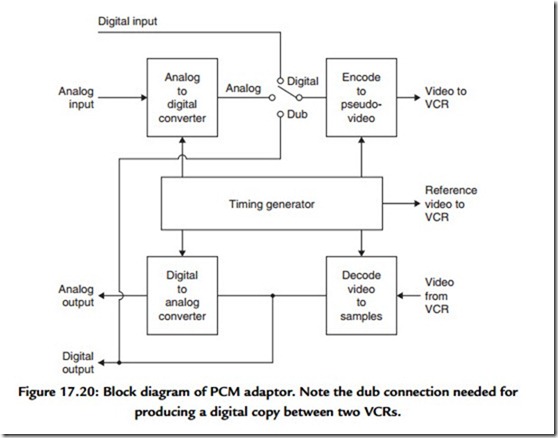The PCM Adaptor
The PCM adaptor was an early solution to recording the wide bandwidth of PCM audio before high-density digital recording developed. The video recorder offered sufficient bandwidth at moderate tape consumption. While they were a breakthrough at the time of their introduction, by modern standards PCM adaptors are crude and obsolescent, offering limited editing ability and slow operation.
Figure 17.20 shows the essential components of a digital audio recorder using this technique. Input analogue audio is converted to digital and time compressed to fit into the parts of the video waveform which are not blanked. Time-compressed samples are then odd-even shuffled to allow concealment. Next, redundancy is added and data are interleaved for recording. Data are serialized and set on the active line of the video signal as black and white levels shown in Figure 17.21. The video is sent to the recorder, where the analogue FM modulator switches between two frequencies representing the black and white levels, a system called frequency shift keying (FSK). This takes the place of the channel coder in a conventional digital recorder.
On replay, the FM demodulator of the video recorder acts to return the FSK recording to the black/white video waveform, which is sent to the PCM adaptor. The PCM adaptor extracts a clock from the video sync pulses and uses it to separate the serially recorded bits. Error correction is performed after deinterleaving, unless the errors are too great, in which case concealment is used after the deshuffle. The samples are then returned to the standard sampling rate by the time base expansion process, which also eliminates any speed variations from the recorder. They can then be converted back to the analogue domain.
In order to synchronize playback to a reference and to simplify the circuitry, a whole number of samples is recorded on each unblanked line. The common sampling rate of
44.1 kHz is obtained by recording three samples per line on 245 active lines at 60 Hz. The sampling rate is thus locked to the video sync frequencies and the tape is made to move at the correct speed by sending the video recorder syncs which are generated in the PCM adaptor.
